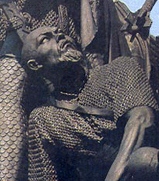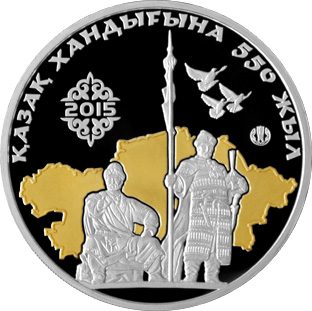
The Golden Horde, self-designated as Ulug Ulus, was originally a Mongol and later Turkicized khanate established in the 13th century and originating as the northwestern sector of the Mongol Empire. With the division of the Mongol Empire after 1259, it became a functionally separate khanate. It is also known as the Kipchak Khanate or as the Ulus of Jochi, and it replaced the earlier, less organized Cuman–Kipchak confederation.

Mamai was a powerful Mongol military commander of the Golden Horde. Contrary to popular misconception, he was not a khan (king), but was a kingmaker for several khans, and dominated parts or all of the Golden Horde for a period of almost two decades in the 1360s and 1370s. Although he was unable to stabilize central authority during the war of succession known as the Great Troubles, Mamai remained a remarkable and persistent leader for decades, while others came and went in rapid succession. His defeat in the Battle of Kulikovo marked the beginning of the decline of the Horde, as well as his own rapid downfall.

Tokhtamysh was Khan (ruler) of the Golden Horde, who briefly succeeded in consolidating the Blue and White Hordes into a single polity.

Abū Saʿīd Janibek Bahadur Khan bin Barak Sultan, otherwise known by his shortened regal name Janibek Khan, was a co-founder and second Khan of the Kazakh Khanate from 1473 to 1480. He was a son of Barak, Khan of the Golden Horde from 1422 to 1427. Barak Khan's father was Koirichak, grandson of Urus Khan, a direct descendant of Genghis Khan. Genghis Khan is Jochi Khan's father, Jochi Khan's son Tukai-Timur, Tukai-Timur's son Uz-Timur, Uz-Timur's son Khodja, Khodja's son Badakun-Uglan, Badakun-Uglan's son Urus Khan, Urus Khan's son Koirchak-khan, Koirchak-khan's son Barak Khan, and Barak Khan is Zhanibek/Janibek's father.

The Tokhtamysh–Timur war was fought from 1386 to 1395 between Tokhtamysh, khan of the Golden Horde, and the warlord and conqueror Timur, founder of the Timurid Empire, in the areas of the Caucasus Mountains, Turkestan and Eastern Europe. The battle between Amir Timur and Tokhtamysh played a key role in the decline of Mongol power over early Russian principalities.
Barak was Khan of the Golden Horde from 1423 to 1429. His father was Quyurchuq, the son of Urus Khan, who was a descendant of Tuqa-Timur, the son of Jochi, the eldest son of Genghis Khan.
Descent from Genghis Khan in East Asia is well documented by Chinese sources. His descent in West Asia and Europe was documented through the 14th century, in texts written by Rashid-al-Din Hamadani and other Muslim historians. With the advent of genealogical DNA testing, a larger and broader circle of people have begun to claim descent from Genghis Khan owing to dubious and imprecise haplogroup identifications. However, while many of Genghis Khan's agnates' resting places are known, none of their remains have been tested to prove or disprove these theories and debate continues.
Urus Khan was the eighth Khan of the White Horde and a disputed Khan of the Blue Horde; he was a direct descendant of Genghis Khan. Urus himself was the direct ancestor of the khans of the Kazakh Khanate.
Temür Malik, also spelled Timur-Malik, the son of Urus Khan, was the ninth Khan of the White Horde. Early during his reign, he successfully invaded the lands of his cousin Toqtamysh. However, Toqtamysh later managed to trap and kill Timur-Malik near Qara-Tal, and succeeded him.
Chimtay was a ruler of White Horde between 1344 and 1360.
Jochi, the eldest son of Genghis Khan, had several sons. When he died, they inherited their father's dominions as fiefs under the rule of their brothers, Batu Khan, as supreme khan and Orda Khan, who, although the elder of the two, agreed that Batu enjoyed primacy as the Khan of the Golden Horde.
Sheikh Ahmed was the last Khan of the Great Horde, a remnant of the Golden Horde.

Ahmed Khan bin Küchük was the Khan of the Great Horde from 1465 to 1481.
Mahmud Astrakhani was one of Küchük Muhammad's sons and a Khan who founded the Khanate of Astrakhan in the 1460s.
Kutlug-Buga was the son and heir of Urus Khan, who was the ruler of the Blue Horde, an eastern part of the Golden Horde and for some time he held the supreme power of the Khan of the Golden Horde. When his father left for the capital of the Golden Horde - Sarai-Berke, Kutlug-Buga served as the ruler of the Blue Horde.
Qāghān Beg was Khan of the Golden Horde from 1375 to 1377. He held the traditional capital Sarai during a period of civil war among rival contenders for the throne. Throughout his reign, the westernmost portion of the Golden Horde was under the control of the beglerbeg Mamai and his puppet khan Muḥammad-Sulṭān, while the easternmost portion was under the control of Urus Khan and then his sons.
Quyurchuq (Qūyūrčuq) was the khan of the Golden Horde in 1395–1397, appointed by Timur (Tamerlane). Information on his life and reign is very limited.

The Great Troubles, also known as the Golden Horde Dynastic War, was a war of succession in the Golden Horde from 1359 to 1381.





